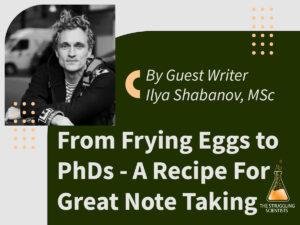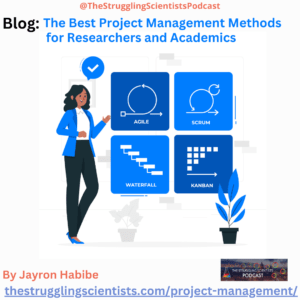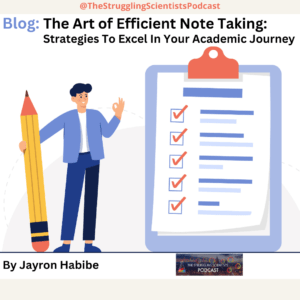When I began my PhD, I had grand ambitions to answer life’s ultimate questions. But as time
passed, I realized it’s more of a stepping stone, or as the Hitchhiker’s Guide would say,
“Mostly Harmless.”
Think of it, what is a PhD exactly? It’s a search for an answer, an elusive “42” that becomes
your thesis. The task is to learn a niche as quickly as you can, then add a small novel idea –
usually a reshuffling of existing knowledge – and write it all down in a way that is logically
sound.
So a PhD is much more about your ability to manage knowledge than it is about the
intricacies of your niche topic! This is what I call Academic Knowledge Management (AKM).
Only a single popular AKM exists: Zettelkasten (invented in the 50s). In its original form,
Zettelkasten is like using a compass to navigate a city instead of Google Maps: Charmingly
archaic!
Today dozens of apps are available that revolutionize the way we manage knowledge, yet
most students or professors do not use them. I think it is because the gain of just a tool
without a system is very small. After writing 300,000 (the volume of 5-10 PhD thesis) words
in notes, I’ve developed a hybrid system that combines the best of both worlds.
Here are my observations, pitfalls, and guidelines:
Linear Transcription: The Vogon Poetry of Note-Taking
Linear transcription means copying and pasting or highlighting text without grasping its
essence. Highlighting PDFs is mostly an act of procrastination. Instead, rephrase what you
learn in your own words even if it means missing some of the contents. Ultimately, it is much
better to have a few facts nailed down, than many facts highlighted and forgotten.
Trust me, months or weeks after conception copy and pasted notes will appear just like
“Vogon poetry” to you.

Key Takeaway: Don’t copy and paste, don’t highlight – instead write your own notes, possibly
sacrificing some content.
Lack of Structure: Navigating Without a Star Chart
Imagine embarking on an interstellar journey without a star chart; you’d be lost in the cosmic
abyss. Similarly, a vault of digital notes without structure is aimless and ineffective. When we
take notes we tend to either skip this step or procrastinate by over-structuring. The result is
that you can’t find anything or it takes you too long to add new notes, which over time results
in not noting down things and again not being able to find them…
Structure is a double-edged sword. And the rule of thumb is: As simple as possible, as
complex as necessary. Start by having a max of 5-10 folders for different notes and curate a
set of summary notes that link together related ideas. These two things can be 90% of your
structure. Tagging, tables, databases, supertags, embedded searches, etc. are all nice to
have, especially early on.
My note-taking system uses only 4 types of notes and looks like this:
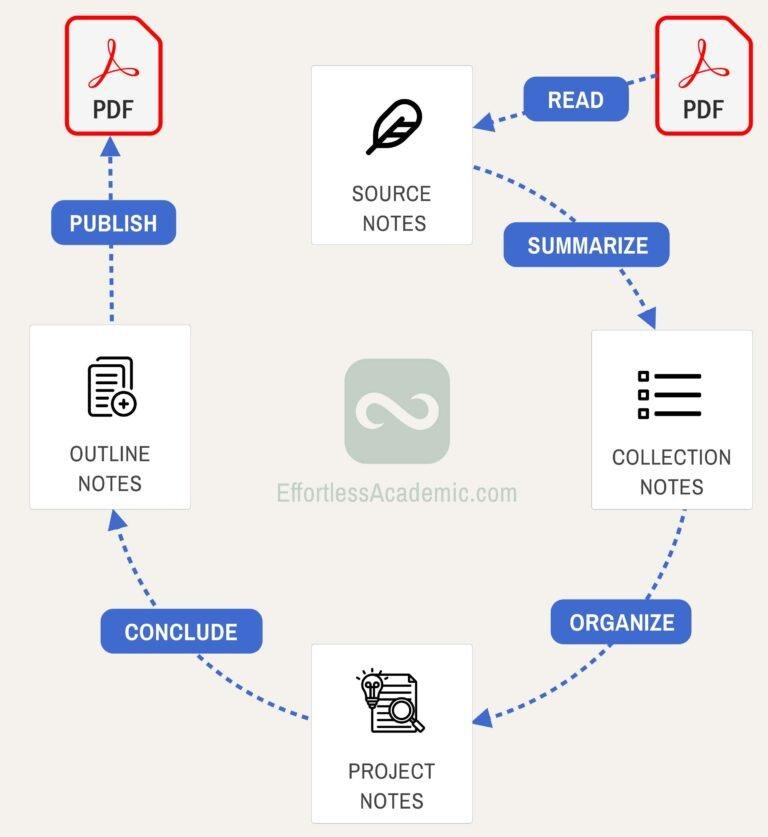
Key Takeaway: Too little structure, you won’t find things – too much structure you won’t use
your notes. Always keep it as simple as possible, as complex as necessary.
Isolation of Ideas
Ideas and notes are gregarious creatures – the more they link together, the happier they are
and the more they “procreate”. Therefore, your goal in an academic knowledge system is to
connect notes and ideas as much as possible. The simplest connection is a link, one step
more complex is a backlink, and more complex still are notes connected through tags or
graphs.
Digital note-taking enhances connectivity and discovery in numerous novel ways. This is
precisely why the Zettelkasten method is so outdated: Digital notes work differently than
paper ones, just like books differ from websites
Key Takeaway: Ideas in isolation are like solitary planets—barren and unproductive.
Over-Cluttering: The Infinite Improbability Drive of Notes
Over-cluttering your notes with excessive details is like using the infamous Infinite
Improbability Drive. You will get somewhere but good luck making sense of it. The key is to
instead be extremely brief in your notes.
Think of notes as a memento to a fact, rather than the fact itself. Remember: Simplification is
sophistication. If you can’t express something succinctly you probably haven’t understood it
fully yet. What we then often revert to is to copy and paste a passage, another cardinal sin of
note-taking.
Key Takeaway: Too much detail in your notes is like an Infinite Improbability Drive—
unpredictable and confusing.
Neglecting Sources: Your Way to Plagiarism
In academia everything needs proof. If you can’t point to a study that proves what you talk
about you just speculate or worse: you plagiarize. This is why adding sources/references to
your notes is the most important part of an academic knowledge system and something that
is generally not necessary with more mundane systems like the very popular “second brain”
Adding sources is actually very simple. Just make a note on the source and link to it whenever
you need a reference. The source note itself can be almost empty and serve entirely as an
anchor
Key Takeaway: Everything needs a reference, create notes with a single purpose of using
them as reference anchors across your notes.
No Review: The Forgotten Towel
Not reviewing your notes is akin to forgetting your towel on an intergalactic hitchhike—both
are essential but often neglected. When you revisit your notes you don’t simply read them,
you refine them and you remember them.
But don’t review for the sake of reviewing, set yourself a goal: “I want to gather all information
on XYZ” and start digging into your notes like you would dig into a paper. Every time you find
some novel connection, just write it down right there in your notes. Every time you do this,
your notes improve!
If you take your notes well they will be densely connected making your review a lot easier, as
you can just click on links. A more advanced technique is to look at the backlinks of a note
and navigate those as well.

Key Takeaway: To review ask yourself a question and read through the notes, adding new
ideas as they appear.
Over-Reliance on Digital Tools
Digital notes are great but don’t be confined by your vault either. Quite often pen and paper
can be a much quicker, more temporary, and more satisfying alternative. Being effortless
means to make use of everything at your disposal.
Some examples where digital notes are not great (yet):
Mathematical formulae: LaTeX is fine but slow, instead scan your formulae
Initial Mindmaps: I am a huge fan of draw.io but admittedly every single one of my digital
mindmaps starts on paper to understand components and layout.
Drawings/Diagrams: There is just no good way aside from screenshots to create quick
and dirty graphics on a computer.
Free Writing: This is an exercise that demands that you just empty your mind with your
writing. Digital notes allow us to correct, refine, and revise, which is often quite hindering
if you just want to feel the flow of ideas
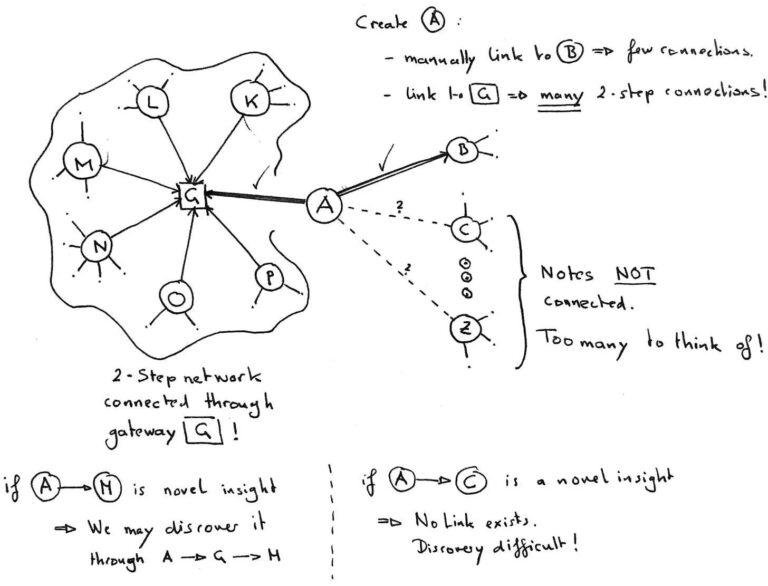
Experiment with your solutions – the simpler ones are often the best ones. But keep in mind
that anything that you want to be part of your academic knowledge management system will
need to be connected, searchable, and centralized. That is your only limitation.
Key Takeaway: Use simpler tools whenever possible, but remember that if you can’t
connect the outcomes to your main note-taking system, you will forget about it
eventually.
Don't panic
In the grand quest for a PhD, effective knowledge management is your “Answer to the
Ultimate Question.” By avoiding common pitfalls and employing best practices, you turn your
PhD journey from a frantic race into a leisurely stroll through the academic cosmos. Think of
your journey as slowly making the right steps in the right direction, rather than running
quickly somewhere.
Have you heard the carpentry proverb: “Measure twice, cut once”? For your PhD it means to
move slowly and let your academic knowledge system make the direction of your movement
well-defined and fruitful.
Don’t panic if you spend weeks reading and making notes, it will pay off, as you then make
giant leaps nobody expected. The moment where your AKM starts thinking for you and
surprising you is a paradigm shift and after it happens, it will keep happening as it always
does once your notes reach a certain size and maturity!
As you traverse the academic universe in search of your own elusive “42,” keep your notes
close, your sources closer, and whatever you do, “Don’t Panic!”. It’s all gonna be alright at the
end and if it is not alright, it is not the end!
Learn More
I created a free 8-day starter guide on academic note taking. It will show you exactly how to
get started and what tools to use!




